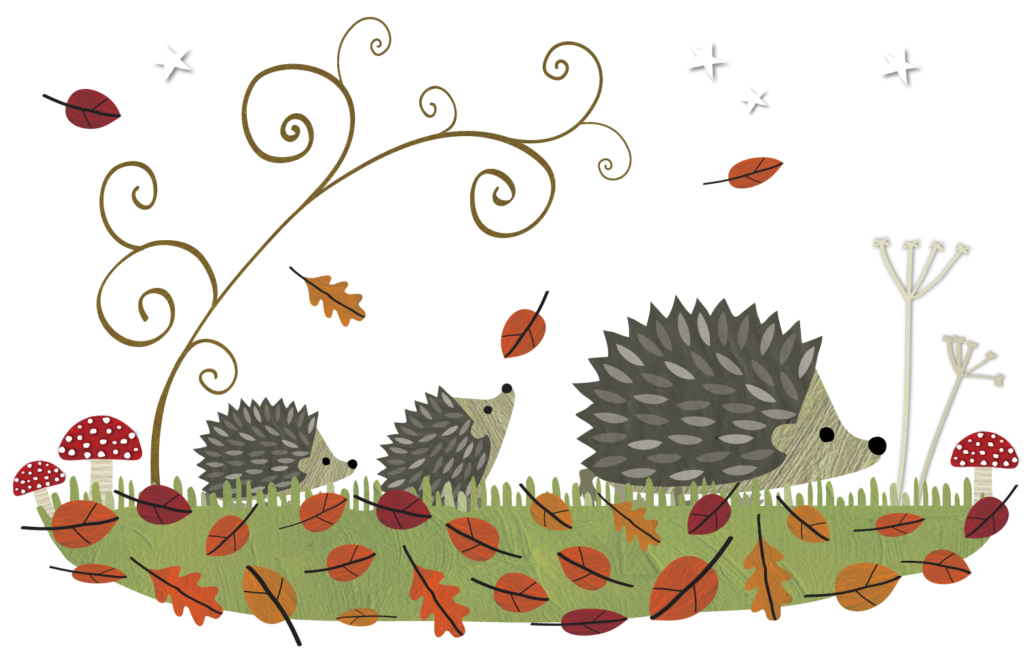
WHAT IS AN AUTUMN JUVENILE?
Autumn juvenile hedgehogs are old enough to be away from their mothers but too small to hibernate successfully. The autumn juvenile season can start as early as September and is busy through until the end of November. However, some will struggle on and the occasional one can be found from December through until April. The season will vary slightly depending whether you live in the south or north and depending on the weather. Those found in March and April may have struggled through the winter or they may have hibernated but at the minimum weight for hibernation, so they are weak when they emerge. The current evidence is that, if otherwise healthy, young hedgehogs weighing over 450g can survive hibernation (Morris, 1984). Giving advice on whether to leave them out in the garden and keep feeding them or whether to bring them indoors and over-winter them can be difficult. Left outside it is more difficult to monitor them and if they start to have problems and hide away, they can just die. If they are brought indoors the stress of captivity can also cause suffering. Therefore, the following advice will be correct for some hedgehogs and not for others.
HEDGEHOGS THAT CAN PROBABLY BE LEFT IN THE WILD
If the hedgehog is a regular visitor to your garden, is only seen at night, appears active and you are prepared to feed it every night then it can be left in the wild. See notes on feeding and feeding stations. However if the hedgehog goes off its food, wobbles and staggers or starts coming out in the day or you notice it has green slimy poo especially if there is blood in it, then it needs extra help as soon as possible (see basic first aid). Even if you must bring a hedgehog in do keep putting food outside as there may be siblings or other autumn juveniles making the most of your hospitality. If the food does not go you could continue to provide dry cat biscuits – these will not go off as quickly as tinned food so are less wasteful. Make sure there is water available, especially if feeding dry foods. It is helpful if you can weigh your visitor at least once a week if its size is a concern to ensure it is putting on weight and doing well. Any under 250g in autumn are likely to be genuine orphans and should be rescued immediately. “Rescue” of autumn juveniles at weights above 450g, based on weight alone, is strongly discouraged.
HEDGEHOGS THAT ARE PROBABLY BEST RESCUED
Hedgehogs are nocturnal so those out in the day are displaying odd behaviour. Even though they appear lively and are rushing around these hedgehogs probably need rescuing in autumn/winter. Once out in the day they can be days away from death. Even when rescued they can seem OK for a day or so and then suddenly collapse and die. Therefore, if out in the day in autumn/winter, whether rushing about or curled up asleep they need rescuing. Hedgehogs do NOT hibernate in the open. They make a nest of leaves etc and disappear into the depths of the nest and are completely hidden.
Hedgehogs found anywhere other than a well-made hibernation nest, that appear to be hibernating (cold and curled-up) are unlikely to survive and should be rescued immediately. If, after evaluation by an experienced hedgehog rehabilitator, it is judged to be fit, it can be re-released as soon as possible in its original location during a mild spell of weather. If a hedgehog is accidentally disturbed in its nest during hibernation it should normally be left alone to arouse naturally, and it will probably move to a new site.
As a general rule, from the end of October, those under 450 g (1lb) may need to be rescued, depending on the weather (which varies across the UK) and other circumstances. If the hedgehog is otherwise in good health, providing some supplementary food may be all the help it needs. If in doubt call us on 01584 890 801 to find an independent rehabilitator near you and seek their advice.
FEEDING
Creating a wild corner or edge or building a log pile will provide natural food and shelter for visiting hedgehogs. To supplement their natural diet you can offer meaty hedgehog food, meaty cat or dog food or cat biscuits. They will also need dishes of clean water. Spreading the food over multiple sites will reduce the risk of aggressive encounters at food bowls. Scattering some of the food will encourage more natural foraging behaviour.
FEEDING STATIONS
Make a feeding station for hedgehogs (see BHPS poster ‘Feeding Station’). Use either a plastic or wooden box and cut a 13cm x 13cm (5” x 5”) hole in one of the short sides. Place this over the food, like a tunnel, so the hedgehog can get through the hole to the food, but it keeps the cats out. A brick on top should stop the box being pushed aside. Another brick or large stone placed 13cm (5”) from the entrance should stop a cat lying down and hooking the food out with its paw!
BASIC FIRST AID
If rescue is required, for first aid, line a high-sided box (hedgehogs are good climbers) with newspaper and put it in a warm room. Pick the hedgehog up using a towel and place it in the box; use that towel as some bedding for it. If the hedgehog is lethargic, cold, wobbles and staggers then it needs a hot water bottle or similar. Fill the bottle with warm rather than hot water. Cover the bottle with a towel and place the hedgehog on this but still with its towel covering it as well. The water in the bottle will need to be changed quite frequently to keep it warm. Alternatives to hot water bottles are soft drink bottles full of hot water, ice cream or margarine tubs full of warm water with the lid on, wheat bags (UNFRAGRANCED ONLY cover with a small plastic bag to prevent it becoming soiled), a pet snuggle safe or heat pad or a reptile heat mat. Do not use back warming pads for human use, as they are not designed to be urinated on! Make sure the bottle always stays warm (not hot) and that there is room to move off the bottle if the hedgehog gets too hot. Provide food and water in the box and then SEEK ADVICE (including the numbers of independent rehabilitators in your area who may be able to help) – telephone us on 01584 890 801. Many autumn juveniles will have lungworms that in turn can cause breathing difficulties. Those already showing problems i.e. out in the day will be most at risk and are likely to have the highest worm burdens. Symptoms may include lack of appetite, no weight gain even when eating, coughing and rapid breathing. These will need worming and antibiotics which is why it’s important to get the casualty to an independent rehabilitator who can arrange urgent treatment. All rescued hedgehogs should be passed on to an experienced hedgehog rehabilitator as soon as possible to give them the best chance of survival.
OVER-WINTERING
We strongly suggest getting the hedgehog checked over by an experienced independent rehabilitator in the first instance. Then, if the rehabilitator agrees and you are going to help them over-winter the hedgehog it should be weighed daily initially as it can be difficult to tell whether it is eating or just walking through the food. If it stays the same weight over a few days or loses weight, then it is best passed back to someone with more experience urgently. Provide the food mentioned above and once it is about 600g (22oz) it can gradually be introduced to a cooler temperature (a bit like hardening off plants). It can eventually go into a shed or garage but do keep feeding it. Let it decide when it wants to hibernate. If the weather is mild, active hedgehogs can be released at 600gms (Yarnell et al 2018). If it was found in your garden or very nearby then you can release it there, late one evening – into a ready-made nest site (contact BHPS for details of Hedgehog Homes). You will also need to provide food and a feeding station. If the hedgehog does not get up to weight, or there are no mild spells, release the hedgehog in the spring. Let the wild hedgehogs be your guide, if they are awake and around it is time for yours to go. However, some males may start to become very restless and try to escape from their box. If this happens as soon as they are up to weight release them at the earliest opportunity or they may become very stressed and could die.
References:
Morris P. A. (1984) An estimate of the minimum body weight necessary for hedgehogs (Erinaceus europaeus) to survive hibernation. Journal of Zoology, London 203:291-294
Yarnell R. et al. (2018) Should rehabilitated hedgehogs be released in winter? A comparison of survival, nest use and weight change in wild and rescued animals. European Journal of Wildlife Research. 65: 6. https://doi.org/10.1007/s10344-018-1244-4







